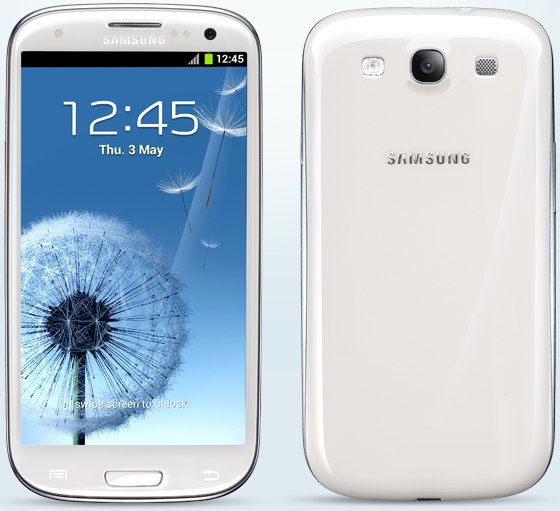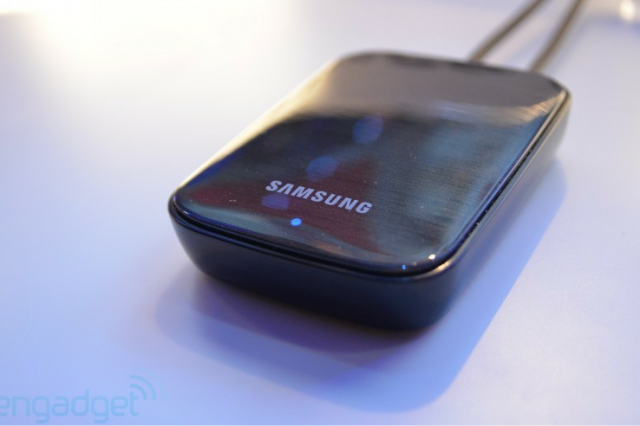
The Galaxy S3 is here, and it’s going to be one of the biggest launches of the year. Let’s run down what you can expect.
Specs
– Android 4.0.4 with a new version of TouchWiz
– 4.8-inch HD Super AMOLED display (1280 x 720)
– 1.5GHz Qualcomm Snapdragon S4 processor (North American version), 1.4Ghz Exynos 4 Quad processor (international version)
– 1GB of RAM
– 16/32GB versions (64GB coming later) with optional microSD slot
– 8MP camera with no shutter lag, 3.3fps burst
– 1.9 front-facing camera with face tracking
– NFC with S Beam
– 2100 mAh removable battery
– HSPA+ (international version) and LTE (North American)
– 136.6 x 70.6 x 8.6 mm, 133g

Main features
The Galaxy S3, in addition to being thin, light and big, is a very iterative upgrade in terms of hardware. At launch there will be two models, Marble White and Pebble Blue. It will come to North America with a 1.5Ghz dual-core Qualcomm Snapdragon S4 processor, while international variants will get a quad-core Exynos 4 Quad chip. Before you get your pants in a bunch, as we showed on on the HTC One X, the S4 chip is plenty fast and plenty battery-efficient despite being dual-core. We’ll have to wait and see how much faster the Exynos 4 Quad is than the Tegra 3, but that shouldn’t discourage you from looking forward to the North American variant.
We’ve also heard that the versions that will come to Canada will retain the popular home button, eschewing the row of four capacitive buttons from devices like the Galaxy SII LTE and Galaxy Note. The phone has many improvements to its build quality, too, which Samsung is summing up as a ‘premium polycarbonate finish.’ There is a removable 2100mAh battery, a microSIM slot and room for a microSD slot up to 64GB in size.

The biggest features are the ones inside the software, and we’ll run them down for you really quickly:
S Voice – A Siri-like feature that responds to your voice. Ask questions like, “What is the weather?” or “Can you play this song?” and it responds quickly and intelligently. You can even launch apps like the camera, separating it from its Apple counterpart in many ways. It will support eight languages out of the box and be configurable with five custom activation methods.
S Beam – An advanced version of the Android Beam feature, S Beam creates a connection with another Galaxy S III using NFC and then uses WiFi Direct to perform a high-speed transfer across devices. Media such as photos, video, MP3s, web pages and contacts are compatible.
SmartStay – A feature that uses the front-facing camera to keep tabs on where your eyes are. If they are reading, the display will not dim. If you lie down and are holding your phone on an angle, SmartStay knows not to switch orientations.
Direct Dial – “It knows when you want to talk: if you’re messaging and want to call instead, simply lift your phone to your ear and it will dial your friend automatically.”
Social Tags – Uses face recognition to detect your friends and incorporate their social networking information directly into the gallery.
Pop-up Play – Uses picture-in-picture abilities to watch video while you’re messaging or browsing. Very cool feature seen in person.
Best Photo – The fast camera can take a burst of eight photos and automatically pick the best one based on facial recognition. It detects who has his or her eyes closed, etc.
AllShare Cast/Play – utilizes DLNA to beam media content and documents to your connected TV. Optional AllShare Cast dongle provides DLNA support to TVs that don’t have it.
Dropbox – Buyers of the Galaxy S III get their Dropbox storage increased to 50GB (much like buyers of the One Series get 25GB). Not bad, Samsung, not bad.
Music Hub – Overhauled interface and an iTunes Match-like feature. Offers 17 million songs for an unknown monthly price.
Accessories

AllShare Cast – As above, the dongle plugs into your non-smart TV and makes it smart, allowing for the wireless streaming of music, movies and photos to your television (Image courtesy of Engadget)
S-pebble MP3 add-on – It’s a 4GB MP3 player that syncs to your phone via a USB cable. No desktop needed.
Flip case – It’s a folio case. That flips.
Spare battery, HDMI dock, car dock, etc. – All these things will come in time.
Canadian Release Dates
At this time, it’s not known when the Galaxy S III will arrive in Canada, other than “this summer.” We also know that the LTE version will come to multiple carriers, likely Rogers, Bell and TELUS; the international version will likely be sold on the new entrants such as WIND, SaskTel and Mobilicity.
Considering the unlocked version is going on sale for £499 on Clove at the end of the month, it will likely sell for between $599 and $699 outright in Canada and the US.
Dual-core vs. Quad-core
With great speeds come compromise, or something along those lines. The international variant of the Galaxy S III will eschew LTE speeds for a quad-core Exynos processor. Initial benchmarks of the 4x Cortex-A9 SoC with an overclocked Mali-400 GPU show results that align with the Tegra 3. In other words, the dual-core Snapdragon S4 SoC is still faster than the the quad-core Exynos 4 chip. Not bad, Qualcomm.
Much of the marketing racket this year is going to be made over dual- vs quad-core, and by virtue of the “moar is better” mentality most consumers have, this will be a difficult battle for manufacturers to win. HTC is facing the same problem, as on paper the Snapdragon S4 chip is much less exciting than a solution with double the cores. But at this stage in the game, double the cores does not equal double the speeds. As we showed you in our One X review, the Snapdragon S4 SoC is currently the world’s fastest smartphone solution, period.
We’ll wait until retail versions of the Galaxy S III with its quad-core Exynos chip hit the market to pass judgement, but until then Snapdragon rules.
Samsung vs. Android
Samsung is playing a very interesting game with the Galaxy S III. By alluding to pebbles, water and many other earthly adjectives to describe its upcoming flagship, it is differentiating its product from the hoards of “droid”-like phones out there running Android.
The word “Android” was barely mentioned during the keynote today. In many ways it doesn’t matter; the Galaxy S III runs TouchWIZ, and it looks remarkably like its predecessor, which ran Gingerbread. Some think TouchWIZ is too cartoony, others too simplistic; others love it, some hate it. But we can all agree that since the original Galaxy S Samsung has kept its software aesthetic remarkably consistent, more so than any other manufacturer. Indeed, the features added to the Galaxy S III — S Voice, S Beam, AllShare Play, SmartStay, Direct Dial — these are all value-added features that can be disabled for whatever reason, but the company is trying very hard to make peoples’ lives easier.
As they said, the phone is made for humans, implying that previous Android devices, including former Galaxy S phones, were more difficult to use than they needed to be. Android has always been labelled as unstable, confusing and user-unfriendly. The SGS III is Samsung’s attempt to change this.
The Verdict
Is the Galaxy S III going to be the phone to buy this summer? Considering how much is riding on its launch, I’d say yes. It’s a capable, fashionable and ultimately worthy successor to the hugely popular Galaxy S II, and with Samsung’s brand power it promises to be equally successful.
What do you think, of the phone and of the surrounding accessory ecosystem sprouting around it? Will you purchase a Galaxy S III in June?
MobileSyrup may earn a commission from purchases made via our links, which helps fund the journalism we provide free on our website. These links do not influence our editorial content. Support us here.


